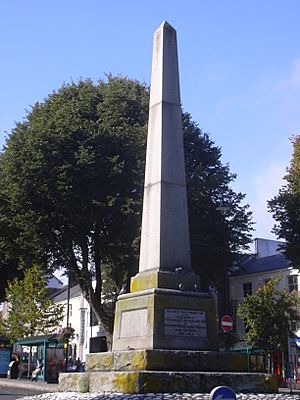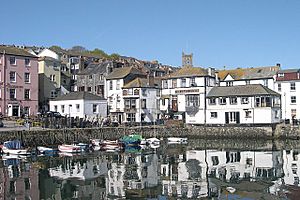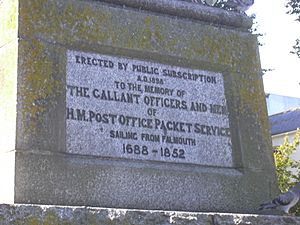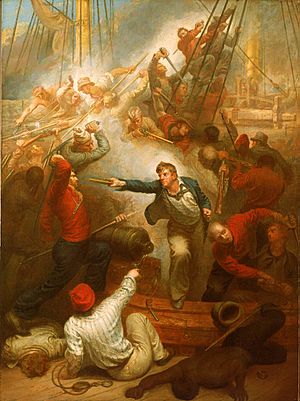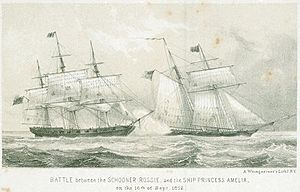Post Office Packet Service facts for kids
The Post Office Packet Service was a special shipping service that started way back in the time of the Tudors. It ran until 1823. Its main job was to carry mail, called "packets," for the General Post Office. These ships traveled to and from British embassies, colonies, and other faraway places.
Besides mail, these ships often carried valuable items like gold, other goods, and passengers. They were usually only lightly armed and relied on their speed to stay safe from enemies. However, Britain was often at war during the 1700s and early 1800s. This meant packet ships sometimes got into fights with enemy warships and privateers (private ships allowed to attack enemy ships). Sometimes, they were even captured!
Contents
Where Did Packet Ships Go?
Packet ships sailed to many parts of the world, connecting Britain with its territories and allies.
Across the Atlantic and Mediterranean Sea
- North, Central, and South America, including the Caribbean Islands.
- Countries in Europe like Spain, Portugal, Gibraltar, Italy, and Greece. For a time, Corfu in Greece was even a British Protectorate (a place protected and partly controlled by Britain).
- Egypt.
To Northern Europe
Routes often started from Dover in Kent or Harwich in Essex. They sailed to places like Calais in France, the Hook of Holland, and Heligoland.
Routes to Ireland
The most common route to Ireland was from Holyhead in Anglesey, Wales, to Dublin or Dún Laoghaire (which used to be called Kingstown). A famous engineer named Thomas Telford even built a new road and the Menai Suspension Bridge to connect London to Holyhead. There was also a route to the Isle of Man.
Where Did Packet Ships Start From?
The main places where packet ships departed were called "stations." These included Dover, Harwich, Great Yarmouth, Falmouth, Plymouth, Milford Haven, and Holyhead.
Falmouth: A Key Station
Falmouth, in Cornwall, was a very important packet station from around 1688. It was a good spot because its location made it easier for ships to get through areas where enemy ships and privateers were lurking. This became even more important when Napoleon tried to stop Britain from trading with mainland Europe.
In 1810, some sailors working for the packet service in Falmouth protested about their pay. They used to be allowed to trade goods for themselves, but this was stopped because it was seen as smuggling. When they lost this extra income, they were unhappy.
Because the sailors refused to work, the Post Office moved the Falmouth station to Plymouth. However, many people from Falmouth and local politicians worked hard to get the service back. After thinking about other places, the Post Office agreed to return the service to Falmouth in January 1811.
Later, in 1843, merchants in Falmouth convinced the government not to move the station to Southampton, even though Southampton now had a railway. The very last packet ship arrived in Falmouth on April 30, 1851. The railway didn't even reach Falmouth until 1863!
Battles at Sea
Packet ships, even though they were mainly for mail, sometimes had to fight enemy ships.
The French captured a British packet ship called Antelope three times! But in between those captures, on December 1, 1793, the Antelope fought and captured a French privateer named Atlante. Even though the Antelope had fewer guns and fewer men, and all three of its officers were dead or hurt, its crew won a very tough fight.
On June 21, 1798, the packet ship Princess Royal was carrying mail to New York. It met a French privateer brig (a type of ship). The Princess Royal had six cannons and 49 people on board, including passengers and young boys. They fought for two hours, with passengers even firing small guns! Eventually, the privateer gave up and sailed away. It was later learned that the privateer was the Avanture, which had 14 cannons and 85 men. It lost two men and had four wounded, and was so damaged it had to go home for repairs.
Another amazing story happened on May 15, 1800. Captain Newman, who used to be on the packet ship Jane, ended up capturing the Lisbon packet Marquis of Kildare. When a French privateer captured the Jane, they let Newman and some of his crew go to Lisbon. On April 29, they sailed from Lisbon on the Marquis of Kildare, heading for Falmouth. Two weeks later, a French privateer captured the Marquis of Kildare. The privateer took off the captain, officers, and most of the crew. But three crew members hid, and Newman, four of his crew, and three passengers (a woman, her sick brother, and father) stayed on board. The privateer put 17 of its own crew members on board to take the ship to Corunna.
When they were about six leagues (a unit of distance) from Corunna, Newman, who had found a pistol, and his crew, who found a cutlass and boarding pikes, managed to chase the French crew off the deck and take control of the ship! Newman then put the French crew in a small boat with food and set them adrift. After more challenges, the Marquis of Kildare finally reached St Ives, Cornwall, on May 31.
A very famous battle happened on October 1, 1807. The packet ship Windsor Castle fought and captured the French privateer Jeune Richard, even though the French ship had more guns. It was a bloody fight, and the bravery of the British crew was talked about a lot in the newspapers.
At the start of the War of 1812, an American privateer named Rossie, led by Joshua Barney, captured the mail packet Princess Amelia after a short but intense fight on September 16, 1812. The Rossie had ten 12-pounder guns and one 9-pounder gun, with a crew of 95. The Princess Amelia had four 6-pounders and two 9-pounders, with a crew of 28. The Princess Amelia had to surrender after losing three men, including her captain, and 11 men wounded.
The Admiralty Takes Over
In 1823, the British Admiralty (the government department in charge of the Royal Navy) took control of the Packet Service. They replaced the older packet ships with naval ships that were no longer needed after the Napoleonic wars ended.
In the 1830s, steam-powered ships started to replace sailing ships. This made the service more regular and reliable.
Over time, the number of packet stations was reduced. Most routes were moved to Southampton, which was now connected to London by railway. Other ports that handled packets included Liverpool (from 1840) and Plymouth (from 1850).
In 1850, the government officially ended the Packet Service. Instead, the Post Office started paying other companies that already had regular shipping services to carry the mail. Ships that had a contract to carry mail were then called Royal Mail Ships. This change was managed by Admiral Parry.
What "Packet" Means Now
After the official Packet Service ended, the word "packet" still came to mean a ship that traveled on a regular schedule, carrying passengers. This is why you might hear about "packet trade" or a "packet boat" even if it doesn't carry official Post Office mail.
See also


